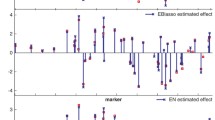Abstract
Missing marker and segregation distortion are commonly encountered in actual quantitative trait locus (QTL) mapping populations. Our objective in this study was to investigate the impact of the two factors on QTL mapping through computer simulations. Results indicate that detection power decreases with increasing levels of missing markers, and the false discovery rate increases. Missing markers have greater effects on smaller effect QTL and smaller size populations. The effect of missing markers can be quantified by a population with a reduced size similar to the marker missing rate. As for segregation distortion, if the distorted marker is not closely linked with any QTL, it will not have significant impact on QTL mapping; otherwise, the impact of the distortion will depend on the degree of dominance of QTL, frequencies of the three marker types, the linkage distance between the distorted marker and QTL, and the mapping population size. Sometimes, the distortion can result in a higher genetic variance than that of non-distortion, and therefore benefits the detection of linked QTL. A formula of the ratio of genetic variance explained by QTL under distortion and non-distortion was given in this study, so as to easily determine whether the segregation distortion marker (SDM) increases or decreases the QTL detection power. The effect of SDM decreases rapidly as its linkage relationship with QTL becomes looser. In general, distorted markers will not have a great effect on the position and effect estimations of QTL, and their effects can be ignored in large-size mapping populations.





Similar content being viewed by others
References
Barton NH, Keightley PD (2002) Understanding quantitative genetic variation. Nat Rev Genet 3:11–21
Browning SR (2008) Missing data imputation and haplotype phase inference for genome-wide association studies. Hum Genet 124:439–450
Butruille DV, Guries RP, Osborn TC (1999) Linkage analysis of molecular markers and quantitative trait loci in populations of inbred backcross lines of Brassica napus L. Genetics 153:949–964
Doerge RW (2002) Mapping and analysis of quantitative trait loci in experimental populations. Nat Rev Genet 3:43–52
Garcia-Dorado A, Gallego A (1992) On the use of the classical tests for detecting linkage. Heredity 83(2):143–146
Hedrick PW, Muona O (1990) Linkage of viability genes to marker loci in selfing organisms. Heredity 64:67–72
Jiang C, Zeng Z (1997) Mapping quantitative trait loci with dominant and missing markers in various crosses from two inbred lines. Genetica 101:47–58
Li H, Ye G, Wang J (2007) A modified algorithm for the improvement of composite interval mapping. Genetics 175:361–374
Little RJA (1992) Regression with missing X’s: a review. J Am Stat Assoc 87:1227–1237
Lorieux M, Goffinet B, Perrier X, González de León D, Lanaud C (1995a) Maximum likelihood models for mapping genetic markers showing segregation distortion. 1. Backcross population. Theor Appl Genet 90:73–80
Lorieux M, Perrier X, Goffinet B, Lanaud C, González de León D (1995b) Maximum likelihood models for mapping genetic markers showing segregation distortion. 2. F2 population. Theor Appl Genet 90:81–89
Luo L, Xu S (2003) Mapping viability loci using molecular markers. Heredity 90:459–467
Lynch M, Walsh B (1998) Genetics and analysis of quantitative traits. Sinauer Associates, Inc, Sunderland, MA
Mackay TFC (2001) Quantitative trait loci in Drosophila. Nat Rev Genet 2:11–20
Martínez O, Curnow RN (1994) Missing markers when estimating quantitative trait loci using regression mapping. Heredity 73:198–206
Paterson AH, Damon S, Hewitt JD, Zamir D, Rabinowitch HD, Lincoln SE, Lander ES, Tanksley SD (1991) Mendelian factors underlying quantitative traits in tomato: comparison across species, generations, and environments. Genetics 127:181–197
Tai GCC, Seabrook JEA, Aziz AN (2000) Linkage analysis of anther-derived monoploids showing distorted segregation of molecular markers. Theor Appl Genet 101:126–130
Wang J (2009) Inclusive composite interval mapping of quantitative trait genes. Acta Agronom Sinica 35(2):239–245
Wang J, van Ginkel M, Podlich D, Ye G, Trethowan R, Pfeiffer W, DeLacy IH, Cooper M, Rajaram S (2003) Comparison of two breeding strategies by computer simulation. Crop Sci 43:1764–1773
Wang J, van Ginkel M, Trethowan R, Ye G, Delacy I, Podlich D, Cooper M (2004) Simulating the effects of dominance and epistasis on selection response in the CIMMYT Wheat Breeding Program using QuCim. Crop Sci 44:2006–2018
Xu S (2008) Quantitative trait locus mapping can benefit from segregation distortion. Genetics 180:2201–2208
Ye S, Zhang Q, Li J, Zhao B, Li P (2005) QTL mapping for yield component traits using (Pei’ai 64s/Nipponbare) F2 population. Acta Agronom Sinica 31:1620–1627 (in Chinese with English abstract)
Ye S, Zhang Q, Li J, Zhao B, Yin D, Li P (2007) Mapping of quantitative trait loci for six agronomic traits of rice in Pei’ai 64s/Nipponbare F2 population. Chin J Rice Sci 21(1):39–43 (in Chinese with English abstract)
Yu Z, Schaid DJ (2007) Methods to impute missing genotypes for population data. Hum Genet 122:495–504
Zhang L, Li H, Li Z, Wang J (2008) Interactions between markers can be caused by the dominance effect of quantitative trait loci. Genetics 180:1177–1190
Zhu C, Wang C, Zhang Y (2007) Modeling segregation distortion for viability selection. I. Reconstruction of linkage maps with distorted markers. Theor Appl Genet 114:295–305
Acknowledgments
This work was supported by the National 973 Projects of China (no. 2006CB101700) and Natural Science Foundation of China (no. 30771351).
Author information
Authors and Affiliations
Corresponding author
Additional information
Communicated by E. Carbonell.
L. Zhang, S. Wang and H. Li contributed equally to this work.
Electronic supplementary material
Below is the link to the electronic supplementary material.
Rights and permissions
About this article
Cite this article
Zhang, L., Wang, S., Li, H. et al. Effects of missing marker and segregation distortion on QTL mapping in F2 populations. Theor Appl Genet 121, 1071–1082 (2010). https://doi.org/10.1007/s00122-010-1372-z
Received:
Accepted:
Published:
Issue Date:
DOI: https://doi.org/10.1007/s00122-010-1372-z



